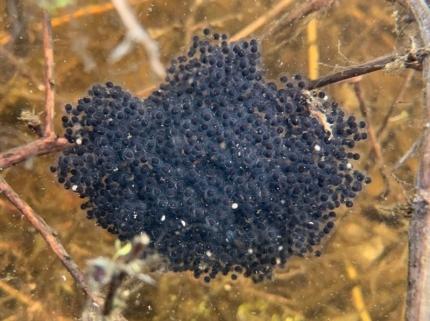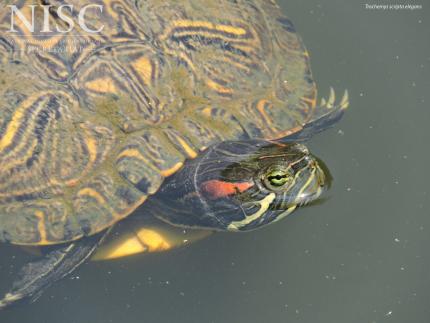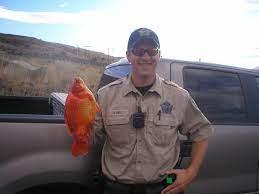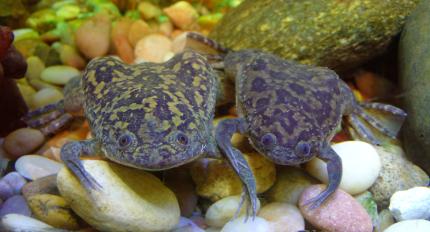Moderate-
High
Only one native population of this frog remains in Washington, but WDFW and partners are working together to help recover this species.
Description and Range
Physical description
The northern leopard frog is a medium to large (3 to 4 inches snout to vent length) aquatic frog with a slender body, thin waist, long legs, and smooth skin. The dorsal (topside) color is brown or green. The northern leopard frog is the only Washington frog with distinct round or oval dark spots arranged in two to three irregular rows between conspicuous light-colored dorsolateral folds (ridges along back and sides). The presence of these folds separates native Washington True Frogs (Rana species) from other Washington anurans. The northern leopard frog’s spots typically have a light border. Spotting also occurs on the limbs. The dorsolateral folds extent to the groin. The belly is cream or white with no dark markings.
Larvae
The tadpole (aquatic larval stage) has an oval body with dorsal eyes, a vent on the right side, a spiracle on the left side and a dorsal fin that originates on the body near the dorsal tail-body junction. The tip of the tail is pointed. The tail fin is translucent with or without fine dark markings. At hatching, tadpoles are uniformly dark. As they increase in size, they develop silver or gold pigmentation over the body and concentrated on the belly. The intestines are clearly visible through the abdominal muscles.
Tadpoles of the American bullfrog and Columbia spotted frog are similar and occupy the same range. American bullfrog tadpoles have distinct black spots over the dorsal surface of the body. Other references should be consulted to accurately separate leopard frog and Columbia spotted frog tadpoles, but in general, leopard frog tadpoles differ in lacking dark mottling on the tail fin and having abdominal muscles that are nearly transparent.
Eggs
Egg masses are 2.5 to 4 inches wide and contain up to 7000 eggs. They are typically attached to vegetation in shallow water. Smaller clusters of 20 to 40 eggs may be present near the main cluster. The ova are less than 0.9 inches in diameter. The gelatinous covering around the eggs is thin resulting in eggs that are packed closely together within the mass.

The Columbia spotted frog is the only amphibian within the Washington range of the leopard frog that also has grapefruit-sized globular egg masses. Leopard frogs do not have multi-clustered egg masses placed together in one pile, but rather they attach single egg masses to vegetation in water over 6 inches deep. Spotted frogs have a thicker jelly coat around the eggs and therefore the eggs do not appear tightly packed within the mass (except when the egg mass is first laid).
For more details about the northern leopard frog, see the Washington Herp Atlas (PDF).
Ecology and life history
Northern leopard frogs are semi-aquatic, requiring both aquatic and terrestrial habitats. Breeding occurs in shallow, still water. Typically these areas are exposed to sunlight and have thin but sturdy vegetation stems for egg attachment. In central Washington, breeding takes place in March-May. Males vocalize with a low snore followed by low grunts to attract females to breeding locations.
A grapefruit-sized egg mass is deposited just below the water surface and attached to vegetation. Eggs may hatch within a few days or weeks depending on water temperature. Tadpoles forage mainly on algae and detritus, and complete metamorphosis in 60 to 90 days. Newly metamorphosed frogs emerge from ponds starting in mid-July.
During the active season, leopard frogs eat a variety of insects and small frogs. They forage on pond edges, damp meadows, marshes, fields, irrigation ditches, and scrublands.
They typically overwinter under water, and require deep, well-oxygenated water that does not freeze solid to the sediments.
Northern leopard frogs may be preyed on by many species throughout their life history, but the most common are likely mustelids, bullfrogs, and fish.
Geographic range
The northern leopard frog has experienced range-wide declines throughout the western United States and Canada. Historical occurrences range from the Columbia Plateau, Okanogan and Canadian Rocky Mountain Ecoregions. Northern leopard frogs were found throughout eastern Washington, and 17 occupied sites were recognized throughout the Columbia, Crab Creek, Pend Oreille, Snake, Spokane, and Walla Walla river drainages. The last known population of northern leopard frogs in Washington is in the Columbia Basin Wildlife Area.
This map from the Washington Herp Atlas illustrates the known distribution of northern leopard frog in Washington as of 2016. If you see this species in areas that are not indicated on the map, please share your observation using the WDFW wildlife reporting form.
For a map of range-wide distribution and conservation status of this species, check out NatureServe Explorer.
Climate vulnerability
Sensitivity to climate change
Moderate-
High
Limited information was available regarding the sensitivity of Washington’s northern leopard frogs to climate change. They may experience some sensitivity to potential increases in temperature, that could lead to earlier timing of mating and breeding. Their sensitivity would be increased by potential climate-induced changes in their pond habitat. Adults need deep water, seasonal ponds, and wetlands for breeding habitat. Potential warmer, drier conditions could lead to declines in available breeding habitat. After breeding, northern leopard frogs will often forage away from the water’s edge in damp-soil marsh edges and meadows. This habitat is likely the most vulnerable to climate change because more extreme summer drying is predicted. This might result in northern leopard frogs utilizing aquatic habitat more frequently during this season. It is unclear how severely this may affect the species. One concern is that it might increase northern leopard frog exposure to bullfrog and fish predation, particularly if the leopard frogs are forced to use reservoir habitat because other aquatic water bodies and edges have dried. Drier conditions could even lead to localized population extinctions if breeding ponds become too shallow or disappear completely.
Exposure to climate change
Moderate-
High
- Increased temperatures
- Changes in precipitation
- Altered hydrology
- Reduction in non-breeding active season habitat in summer
Regulations
Licenses and permits
Be advised that collection of this species is only permitted under a WDFW Scientific Collection Permit for research and educational activities.
Rules and seasons
Due to the significant reduction in range and abundance of leopard frogs in Washington, and the continued threats to the remaining occupied sites, leopard frog were classified as an endangered species in Washington in 1999. The law protects endangered species and prohibits them from being hunted, taken maliciously, harassed, or possessed. This is for all life stages including adults, juveniles, tadpoles, and eggs. Keeping this species as a pet in Washington is also prohibited because species native to the state cannot be kept in captivity. The only exceptions are for zoos, educational centers, rehabilitation facilities, and research facilities that receive permits from WDFW.
Conservation
Conservation Threats and Actions Needed
- Invasive and other problematic species
- Threat: Non-native aquatic species including American bullfrogs, mosquito fish and other non-native predatory game fish. Bullfrogs are predatory for all life stages of northern leopard frogs.; mosquito fish prey on amphibian egg masses and tadpoles. Non-native predatory game fish, such as bass, prey on the frogs and tadpoles.
- Action Needed: 1. Remove mosquito fish from ponds previously occupied by northern leopard frogs. 2. Prevent introduction of non-native fish to ponds occupied by northern leopard frogs. 3. Manage habitat to favor this frog but not favor bullfrogs and fish (example, create seasonal ponds). 4. Create and maintain barriers such as dikes that prevent non-native fish from entering ponds occupied by this species.
- Threat: Unknown impacts to population from disease.
- Action Needed: Additional disease monitoring is necessary to determine the extent of the disease threat in the Northern Leopard Frog Management Area on the Columbia Basin Wildlife Area.
- Threat: Wetland succession and tall emergent vegetation encroachment (example, reed canary grass, phragmites, and non-native cattails) reduces suitability of habitat.
- Action Needed: Set back succession, reduce tall emergent vegetation and encourage short emergent cover through chemicals and mechanical treatments.
- Fish and wildlife habitat loss and degradation
- Threat: Loss of suitable habitat due to water management in the Potholes Reservoir (drawdowns, backups).
- Action Needed: Create and restore breeding habitat (seasonal ponds).
- Agriculture and aquaculture side effects
- Threat: The Odessa Supplemental Feed Route will influence water levels in Potholes Reservoir and may impact the amount of suitable habitat in the Northern Leopard Frog Management Area on the Columbia Basin Wildlife Area.
- Action Needed: 1. Maintain suitable habitat to allow for dispersal and movement. 2. Monitor population. 3. Pursue opportunities to establish new populations. 4. Use adaptive management to deal with the high level of uncertainty regarding potential habitat changes.
See the Climate vulnerability section for information about the threats posed by climate change to the northern leopard frog.
Our conservation efforts
Only one native population remains in Washington. Efforts are underway to recover this species in central Grant County. WDFW is partnering with Washington State University, U.S. Fish and Wildlife Service, Oregon Zoo, and Northwest Trek to better understand population status and trends, to improve habitat conditions, and to reintroduce a northern leopard frog population to the Columbia National Wildlife Refuge.
Living with wildlife
Learn about living with frogs. Understanding wildlife is key to reducing human/wildlife conflicts. The Washington Department of Fish and Wildlife offers a wide range of information designed to minimize conflicts between humans and wildlife, as well as attracting beneficial wildlife and helping residents better understand the animals in their backyards.
Preventing conflict
Minimizing the Impact of Pets
Pets are often important parts of our families and lives. They help teach valuable life lessons and bring happiness. When done correctly, pet ownership can increase our quality of life. However, when people release pets or they escape into the wild, they can create great harm to our ecosystems and decrease our quality of life. Most pets released into the wild will suffer and die, but some survive and can cause millions of dollars in damages. There are examples all over the world of pets that have been released, established populations, and caused damage to natural systems. In Washington, northern leopard frogs have been reduced to just one population and are listed as a state endangered species. Below are some examples of common pet species that could affect our native northern leopard frog population and how they may affect them.
Before acquiring a pet, please consider their needs, behavior, lifespan, and your level of commitment to the animal. For more information on invasive species and issues with released pets, visit the links provided below.
Preventing the spread of invasive species
Red-eared sliders

Red-eared sliders are the most popular pet turtle species in the United States and the most traded reptile in the world. Its popularity as a pet has led to the species being listed on the IUCN top 100 most invasive species. The typical mode of introduction is by pet owners who release individuals into the wild. Due to its long lifespan, ~30 years, released pets may be isolated for years before the addition of more red-eared slider pets leads to the establishment of populations and further spread of the non-native species. Red-eared sliders are now found on all continents besides Antarctica. Although native to the southeast United States the red-eared slider is incredibly cold tolerant and can brumate (reptilian hibernation) over winter under the ice during Washington’s cold winters. Red-eared sliders have been known to both directly affect frog populations by consuming tadpoles and adults, and indirectly they have been linked to decreased tadpole growth, activity, and size at metamorphosis (Vodrazkova et al. 2022).
Goldfish and Carp

Many of us have fond memories of owning goldfish as pets when we were young. For many of us they are also our first encounter with death, and the subsequent flush down the toilet. However, some fish survive the flush or are released by owners who can no longer care for them. Goldfish can grow to be very large and cause considerable disruption to natural systems. Goldfish are considered an Aquatic Invasive Species in Washington.
Goldfish are closely related to another invasive species of fish, the common carp. Carp are found throughout the state and many enjoy them for recreational fishing because of their robust populations, the shallow water they inhabit, and large size to which they can grow. Thus, they have been moved around WA and are now well established in many watersheds. Unfortunately, the characteristics that make them a good recreational fish are also characteristics that make them a harmful invasive species. Mature female carp carry hundreds of thousands of eggs. During spawning, these large fish use shallow water habitat with emergent vegetation. This habitat is also used as breeding habitat by northern leopard frogs during the same time of year. The result is that carp displace the frogs or disturb delicate egg masses that are attached to the emergent vegetation. Carp also forage on emergent vegetation, resulting in significantly degraded habitat that effects leopard frogs, as well as other native amphibian, fish, and waterfowl species. Common carp are considered an Aquatic Invasive Species. Read more about carp on the WDFW common carp page.
Non-native Northern Leopard Frogs
Non-native northern leopard frogs from outside of Washington were discovered in the Spokane area in 2018 based on DNA analysis completed by Washington State University. Leopard frogs are very common in other areas of the United States, and often used in laboratories or kept as classroom pets. Though these are important uses for the species, these animals are not genetically the same as the northern leopard frogs present in WA. Conserving genetically distinct populations help species be more resilient during times of environmental change. Non-native frogs could result in direct competition for space and food, making it more difficult for the native population to survive. Most importantly, the exact impacts of non-native northern leopard frogs on our native population are unknown and could have unexpected negative consequences to the local ecosystem.
African clawed frogs

African clawed frogs were an easily accessible and easy to care for species. These frogs are now listed as a Prohibited Aquatic Animal Species. African clawed frogs were first discovered in King County in 2015 and have since been found in several other areas around Washington. African clawed frogs can disrupt northern leopard frog habitat by eating tadpoles and competing with native frogs for habitat and food. However, the biggest issues with introduced frog species is the potential for spreading disease. Frogs are the most endangered taxa in the world due to the spread of Ranavirus and amphibian Chytrid fungus. Although your pet may look healthy, they can carry and spread the pathogens if released. For more information on WDFW’s response to this species, visit the WDFW African clawed frogs page.
American Bullfrogs
The American Bullfrog is another amphibian that poses problems to the conservation of northern leopard frogs in Washington. Bullfrogs have been documented eating northern leopard frogs of various life stages. Bullfrogs are not a native species to Washington and were brought here as a human food source and as pets. They have been linked to declines in many species of amphibians throughout the west. Bullfrogs are also a Prohibited Aquatic Animal Species in Washington state, meaning no one is to possess, sell, propagate, or release bullfrogs into state waters. For more information about this species, visit WDFW’s bullfrog page.
Insects and Crayfish
There are many invertebrates that could potentially affect northern leopard frog populations. The Northern Crayfish (Faxonius virilis) is one example of a non-native invertebrate currently residing in the WA northern leopard frog range. The impact of this species is poorly known. However, they are now found throughout the Columbia River Basin (Larson et al. 2010). One of the likely sources and subsequent spread of the northern crayfish throughout the Basin is the bait industry. Several different kinds of crayfish are sold as bait including the Rusty Crayfish. For more info on invasive crayfish click here.
Invasive pests in the commercial farming industry are of huge concern to Washingtonians, as Washington is one of the largest fruit growing and timber states in the country. Be sure to follow rules and regulations on the movement of fruits and firewood to prevent the spread of invasive pests.There are many insects that are readily available for multiple purposes from education to weed control. When purchasing these insects do your research to be sure they are allowed to be used, where they are sourced from, what impact they may have if released, etc.
Cats
Domestic cats can be a threat to, not only amphibians, but native birds, mammals, and reptiles too. For more information, please visit Wild Washington Lesson Plans: Protecting Cats and Wildlife.
Resources
References
Alberta Northern Leopard Frog Recovery Team. 2005. Alberta Northern Leopard Frog Recovery Plan, 2005-2010. Alberta Sustainable Resource Development, Fish and Wildlife Division, Alberta Species at Risk Recovery Plan no. 7. Edmonton, AB. 26pp.
Corkran, C. C. and C. Thoms. 1996. Amphibians of Oregon, Washington and British Columbia. Lone Pine, Redmond, Washington. 175 pp.
McAllister, K.R., W.P. Leonard, D.W. Hays and R.C. Friesz. 1999. Washington State status report for the Northern Leopard Frog. Washington Department of Fish and Wildlife, Olympia. 36 pp.
McDiarmid, R. W. and R. Altig (editors). 1999. Tadpoles: The Biology of Anuran Larvae. University of Chicago Press. xvi + 444 pp.
Nussbaum, R. A., E. D. Brodie, Jr., and R.M. Storm. 1983. Amphibians and Reptiles of the Pacific Northwest. University of Idaho Press, Moscow, Idaho. 332 pp.
Stebbins, R. C. 1985. A Field Guide to Western Reptiles and Amphibians, 2nd Edition. The Peterson Field Guide Series. Houghton Mifflin Company, Boston. 336 pp.
Stebbins, R. C. and N. W. Cohen. 1995. A Natural History of Amphibians. Princeton University Press, Princeton, New Jersey, 316 pp.
Personal communications
Steve Germaine, Washington Department of Fish and Wildlife, Olympia, Washington.
David Hays, Washington Department of Fish and Wildlife, Olympia, Washington.
Heather Simmons, Biology Department, Central Washington University, Ellensburg, Washington.
Joann Wisniewski, Washington Department of Fish and Wildlife, Moses Lake, Washington.
WDFW publications
- Hallock, L. A. and K. R. McAllister. 2005. Northern Leopard Frog. Washington Herp Atlas. 2009. A cooperative effort of Washington Natural Heritage Program, Washington Department of Fish and Wildlife, U.S.D.I. Bureau of Land Management, and U.S. Forest Service. Map products updated March 2017. Provisional PDF version of the website (2005-2019) created July 2019. 250 pp.
PHS Program
Status reports
WDFW educational resources
- Wild Washington Lesson Plan – Herps in Washington - Elementary school students are introduced to the cold-blooded world of reptiles and amphibians, also known as herps.
- Family Education – Amphibians and Reptiles - Slither, hop, or crawl on over to learn about herpetofauna!
Other resources
